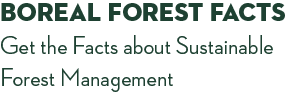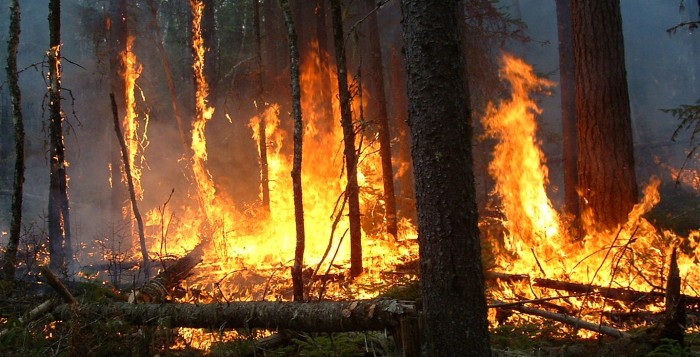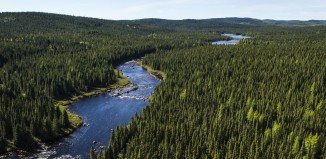Five Burning Questions about Forest Fires
While certainly a threat to public safety and property, forest fires have an important role to play in the life of a forest. Here are five answers to the big questions surrounding wildland fires:
- How do fires start?
Lightning is often the cause of wildland fires in more remote regions during the summer when dry conditions can persist. But Natural Resources Canada (NRCan) estimates that more than half of a season’s fires can be attributed to human causes like a spark from machinery to carelessness in the form of unattended campfires, discarded cigarettes and uncontrolled yard waste burns.[2] But for Canada’s boreal forest, the main ignitor is lightning.
See a live map of current lightning activity in Canada.
- How do they spread so quickly?
Beyond a source of ignition, wildland fires also need dry fuel and hot, dry, windy weather. And to continue to burn, they need heat, oxygen, and fuel (this is known as the fire triangle). Once ignited, fires can move quickly – up to 23 kph by some estimates.[3] And depending on the amount and type of fuel available, the weather and the topography, a fire can continue to spread. The heat from the existing burn causes the moisture in the adjacent fuel to evaporate so that it becomes easier to ignite. Wind provides the flames with oxygen and pushes the fire across a landscape at a faster rate. A large fire will also create a wind of its own, sometimes as much as 10 times faster than the ambient wind, which will propel embers high into the air to start fires in other areas.[4]
- Are all fires as dramatic as the images we see in the news?
No. There are essentially three different types of fires. The ones you see most often in images and news reports are called crown fires because they burn up to the top of a tree. These ones are considered most dangerous. Surface fires burn fuel elements like dried leaves, branches and pine needles on the forest floor. They tend to be easier to control and put out. The last one, the ground fire, is a subsurface fire that can even occur underground where there are deep accumulations of dead vegetation that have become dry enough to burn. These ones tend to smoulder for long periods.
Watch a high-intensity crown fire from the ground as it moves through an area.
- What is the role of fire in forest ecology?
In a word, it’s about diversity. And particularly for the boreal, which is composed of everything from pure deciduous to mixed deciduous-coniferous to pure coniferous. Decay doesn’t occur as quickly under the boreal’s cool temperate conditions as it might in warmer, more humid climates so fire is a natural way to convert the branches, logs and leaves on the ground to a mineral-rich ash. This releases and recycles nutrients.
The gaps in the forest created by fire also allow sun to penetrate and stimulate the growth of pioneer species like aspen, white birch, jack pine and lodgepole pine. If fire does not occur in this same forest over the next 100 years, black spruce will flourish in the shade these pioneer species provide.
And as birds carry seeds to new areas, a patchwork of vegetation develops, populated by different species at various levels of maturity. By rearranging vegetation, fires support the formation of diverse ecosystems that are home to a variety of populations of insects, mammals and birds.
- When is a fire simply allowed to burn?
It generally comes down to whether the fire poses a risk to human life and property. For most of the 20th century, forest fires were seen as a destructive force that needed to be suppressed. And we were generally successful. But we’ve since come to understand that fire, like wind and water, is just another element of the ecosystem. Today’s forest fire strategies range from putting out a fire to actually setting fires on purpose (these are known as prescribed burns and are used to eliminate potential fuel sources).
Learn more about how Ontario air crews set prescribed fires.
Agencies responsible for fire suppression in an area have a number of tools available to them to assess the risk to humans and property. As NRCan explains, high-priority areas for protection include residential areas, high-value commercial forests and recreational sites. Low-priority sites are generally wilderness parks and remote forests of limited economic value—although protection of rare habitat, culturally significant areas and similar values will influence suppression decisions.[5]
[1] http://www.cbc.ca/news/canada/thunder-bay/forest-fire-season-quiet-in-ontario-compared-to-average-1.3227997
[2] http://www.nrcan.gc.ca/forests/fire-insects-disturbances/fire/13145
[3] http://science.howstuffworks.com/nature/natural-disasters/wildfire.htm
[4] http://science.howstuffworks.com/nature/natural-disasters/wildfire2.htm
[5] http://www.nrcan.gc.ca/forests/fire-insects-disturbances/fire/13157




